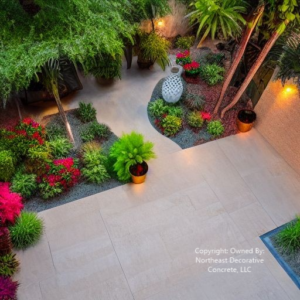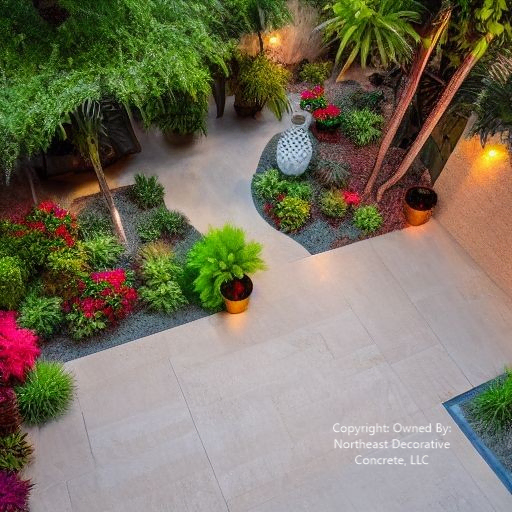
How Long After Sealing Stamped Concrete Can You Walk On It?
So, you had some new decorative concrete installed in your driveway or patio area. It looks sharp. But before you go walking all over that pretty new concrete, you need to wait for that sealant to dry properly. Rushing things can mess up the curing time and damage the sealant finish.
I always tell my customers to wait at least 3 to 5 days after final coat before walking on it, to be safe. Also, I tell them to give it at least 7 days before putting furniture on the surface, or vehicular traffic.
We’ll walk through all the steps to allow that stamped concrete to dry. This way, you can enjoy the finished results for years without any headaches. There is straightforward stuff here – take your time and let chemistry work its magic!
Here is a table summarizing the timeline. It shows when you can walk on different types of concrete sealers.
| Sealer Type | Touch Dry | Foot Traffic | Full Cure |
|---|---|---|---|
| Water-Based | 1 to 3 hours | 24 hours | 36 hours |
| Solvent-Based | 4-12 hours | 36-48 hours | 48 hours |
| Epoxy | 10-12 hours | 12-24 hours | 7 days |
How High Gloss Concrete Sealers Protect Stamped Concrete
When you pour and stamp concrete, it creates a porous and vulnerable finished surface. All those little holes and indentations look nice. But, they leave it prone to stains, cracks, pitting, and other damage over time.
That’s why a protective sealant gets rolled or sprayed over the top. It soaks into those pores and creates a protective barrier. Sealants come in all types, like acrylics, epoxy resins, and polyurethanes. They all work to shield the existing concrete mix and lock in the color.
Sealants make the concrete waterproof. They also make it resistant to salt, oils, chemicals, UV rays, and other hazards. But they need proper drying times to harden and bond. Rushing this process ruins the finish and protection.

Residential & Commercial Decorative Concrete Curing Timeline Effects
Concrete surface sealants have come a long way over the years. But, they still need adequate time before allowing walking traffic. Manufacturers provide specific temperature guidelines.
Here are some general timeframes for different temperature conditions.
| Sealer Type | Low Temp Effect | High Temp Effect | Ideal Temp Range |
|---|---|---|---|
| Water-based | Slows dry time, weakens film | Flash dehydrating, whitening | 50-80°F |
| Solvent-based | Extends drying time | Speeds air drying, trapped bubbles | 50-90°F |
| Epoxy | Slows evaporating reaction | Speeds up wicking reaction | 60-85°F |
These timeframes can vary based on temperature, humidity, sunlight, and other factors. When in doubt, allow a little extra time. Rushing it risks leaving permanent scuffs, tracks, and stains on that pristine new concrete floor.
Telltale Signs the Driveway Sealant Isn’t Cured Yet
Testing, if the sealant is ready early, can be tempting by cautiously walking on it. Even careful footsteps can leave marks if the concrete driveway, sidewalk, or pool deck isn’t thoroughly dried.
Here are some giveaways the sealant isn’t ready for walking traffic:
-
Surface Still Feels Tacky – Sealant will dry from the top down over several days. If you still feel gumminess or stickiness underfoot, you need more time.
-
Imprints Left Behind – Check for imprints left from shoes or furniture legs. Any impressions mean the sealant is still too soft for traffic.
-
Color Comes Off on Shoes – See any sealant color on your shoes? That means it hasn’t hardened fully. Stay off for now.
-
Lingering Solvent Smell – Most solvent-based sealants have strong odors until thoroughly dried. If you still notice strong fumes, it needs more time.
Observing these warning signs allows you to wait longer before walking on that pristine stamped concrete. A little patience goes a long way for longevity!
Getting Impatient? Try These Tips
It’s only natural to get impatient for that finished stamped concrete you paid good money for! Here are some tips to make the time frame more bearable:
-
Restrict access. Block off the area with cones or caution tape to eliminate temptation for others.
-
Create Alternative Routes: Redirect walking commuters to avoid passing over the sealed surface.
-
Check progress often: Inspect the sealant regularly for drying progress, but don’t walk on it.
-
Remove Distractions: Keep pets, kids, and toys away from the area until fully dry.
-
Read Labels Carefully: Follow manufacturer guidelines precisely for best results.
Staying disciplined lets that sealant completely harden and bond correctly. Just remind yourself: those few extra days are well worth it. You’ll get durable, long-lasting stamped concrete!

Real-World Dry Time Examples
Real-world examples can illustrate how patience with the curing process prevents long-term headaches.
Rushing It: Maria had a stunning slate-stamped patio poured last month. After 10 hours, she cautiously tested the sealant with her shoe. No imprint so she began using the patio lightly. But weeks later, distinct shoe marks and stains appeared from the early traffic. Now she has to have the contractor reseal the entire surface.
Bill waited 7 full days: after his concrete contractor stamped and sealed his basement floor. He stayed patient. Then, he moved his furniture back in. It was tricky storing things elsewhere and restricting kids & pets. But now the game room and laundry areas have stunning, durable floors with zero signs of early wear & tear.
A minor inconvenience up front prevents expensive repairs later! Let those sealants properly dry for maximum stamped concrete longevity.
Final Takeaways
Thank you for reading and learning about letting your beautiful newly stamped concrete fully dry before walking on it!
Here are the key points to remember:
-
Sealed concrete requires 12 – 48 hrs. for proper drying before allowing footpath users.
-
Look for tacky texture, imprints, color transfer, or odors. If you find any, the sealant isn’t ready yet.
-
Be disciplined and patient – creating alternate routes prevents temptation and damage.
-
Following manufacturer guidelines guarantees the best results for your specific application.
Soon, you’ll have durable, resilient textured concrete. It maintains its just-poured sheen for decades. Stay mindful of letting chemistry run its course. Your patience will pay off exponentially!
If any other questions come up on letting sealants dry? Ask in the comments!
Our Locations:
Nashua, NH
North Hampton, NH
Concord, NH

